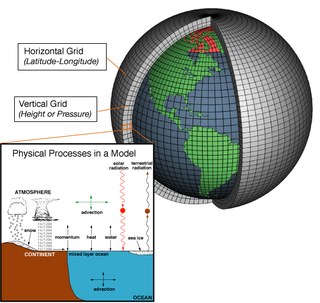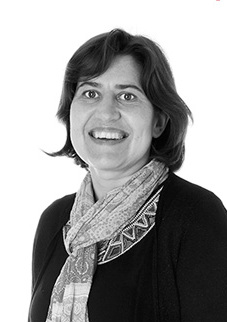Related Research Articles

Climate is the long-term weather pattern in a region, typically averaged over 30 years. More rigorously, it is the mean and variability of meteorological variables over a time spanning from months to millions of years. Some of the meteorological variables that are commonly measured are temperature, humidity, atmospheric pressure, wind, and precipitation. In a broader sense, climate is the state of the components of the climate system, including the atmosphere, hydrosphere, cryosphere, lithosphere and biosphere and the interactions between them. The climate of a location is affected by its latitude, longitude, terrain, altitude, land use and nearby water bodies and their currents.
Cloud feedback is the coupling between cloudiness and surface air temperature where a surface air temperature change leads to a change in clouds, which could then amplify or diminish the initial temperature perturbation. Cloud feedbacks can affect the magnitude of internally generated climate variability or they can affect the magnitude of climate change resulting from external radiative forcings.

A general circulation model (GCM) is a type of climate model. It employs a mathematical model of the general circulation of a planetary atmosphere or ocean. It uses the Navier–Stokes equations on a rotating sphere with thermodynamic terms for various energy sources. These equations are the basis for computer programs used to simulate the Earth's atmosphere or oceans. Atmospheric and oceanic GCMs are key components along with sea ice and land-surface components.

The World Climate Research Programme (WCRP) is an international programme that helps to coordinate global climate research. The WCRP was established in 1980, under the joint sponsorship of the World Meteorological Organization (WMO) and the International Council for Science (ICSU), and has also been sponsored by the Intergovernmental Oceanographic Commission (IOC) of UNESCO since 1993.
In climatology, the Coupled Model Intercomparison Project (CMIP) is a collaborative framework designed to improve knowledge of climate change. It was organized in 1995 by the Working Group on Coupled Modelling (WGCM) of the World Climate Research Programme (WCRP). It is developed in phases to foster the climate model improvements but also to support national and international assessments of climate change. A related project is the Atmospheric Model Intercomparison Project (AMIP) for global coupled ocean-atmosphere general circulation models (GCMs).

This is a list of the most influential long-lived, well-mixed greenhouse gases, along with their tropospheric concentrations and direct radiative forcings, as identified by the Intergovernmental Panel on Climate Change (IPCC). Abundances of these trace gases are regularly measured by atmospheric scientists from samples collected throughout the world. Since the 1980s, their forcing contributions are also estimated with high accuracy using IPCC-recommended expressions derived from radiative transfer models.

Climate sensitivity is a measure of how much Earth's surface will cool or warm after a specified factor causes a change in its climate system, such as how much it will warm for a doubling in the atmospheric carbon dioxide concentration. In technical terms, climate sensitivity is the average change in global mean surface temperature in response to a radiative forcing, which drives a difference between Earth's incoming and outgoing energy. Climate sensitivity is a key measure in climate science, and a focus area for climate scientists, who want to understand the ultimate consequences of anthropogenic global warming.
Ann Henderson-Sellers is an Emeritus Professor of the Department of Environment and Geography at Macquarie University, Sydney. She was the Director of the Joint Planning Staff (JPS) of the World Climate Research Programme in 2006 and 2007 and was the Director of the Environment Division at ANSTO from 1998 to 2005. She was the Deputy Vice-Chancellor of The Royal Melbourne Institute of Technology from 1996–1998. Prior to this she was the founding director of the Climatic Impacts Centre at Macquarie University where she continues to hold a Professorship in Physical Geography.

Roger S. Pulwarty is a scientist from Trinidad and Tobago and contributed to the work of the Intergovernmental Panel on Climate Change (IPCC). Pulwarty is the Senior Scientist in the National Oceanic and Atmospheric Administration (NOAA) Physical Sciences Laboratory in Boulder, Colorado.
This is a list of climate change topics.

The Fifth Assessment Report (AR5) of the United Nations Intergovernmental Panel on Climate Change (IPCC) is the fifth in a series of such reports and was completed in 2014. As had been the case in the past, the outline of the AR5 was developed through a scoping process which involved climate change experts from all relevant disciplines and users of IPCC reports, in particular representatives from governments. Governments and organizations involved in the Fourth Report were asked to submit comments and observations in writing with the submissions analysed by the panel. Projections in AR5 are based on "Representative Concentration Pathways" (RCPs). The RCPs are consistent with a wide range of possible changes in future anthropogenic greenhouse gas emissions. Projected changes in global mean surface temperature and sea level are given in the main RCP article.
The Earth System Grid (ESG) is a data distribution portal whose development is funded mainly by the United States Department of Energy. It is the portal through which the Program for Climate Model Diagnosis and Intercomparison at Lawrence Livermore National Laboratory is distributing data for the IPCC Fourth Assessment Report and the 2014 IPCC Fifth Assessment Report.

Climate change feedbacks are effects of global warming that amplify or diminish the effect of forces that initially cause the warming. Positive feedbacks enhance global warming while negative feedbacks weaken it. Feedbacks are important in the understanding of climate change because they play an important part in determining the sensitivity of the climate to warming forces. Climate forcings and feedbacks together determine how much and how fast the climate changes. Large positive feedbacks can lead to tipping points—abrupt or irreversible changes in the climate system—depending upon the rate and magnitude of the climate change.
Michael Calvin MacCracken, has been chief scientist for climate change programs with the Climate Institute in Washington, D.C., since 2002; he was also elected to its board of directors in 2006.
Piers Forster is a Professor of Physical Climate Change and Director of the Priestley International Centre for Climate at the University of Leeds. A physicist by training, his research focuses on quantifying the different human causes of climate change and the way the Earth responds. He is best known for his work on radiative forcing, climate sensitivity, contrails and Climate engineering. He has contributed heavily to the writing of Intergovernmental Panel on Climate Change (IPCC) reports, including acting as a Lead Author for the Fourth and Fifth Assessment Reports, and a Co-ordinating Lead Author for the Sixth Report. He also acted as a Lead Author of the IPCC 2018 Special Report on Global Warming of 1.5 °C.
Julie Michelle Arblaster is an Australian scientist. She is a Professor in the School of Earth, Atmosphere and Environment at Monash University. She was a contributing author on reports for which the Intergovernmental Panel on Climate Change (IPCC) was a co-recipient of the 2007 Nobel Peace Prize. Arblaster was a lead author on Chapter 12 of the IPCC Working Group I contribution to the IPCC Fifth Assessment Report in 2013. She has received the 2014 Anton Hales Medal for research in earth sciences from the Australian Academy of Science, and the 2017 Priestley Medal from the Australian Meteorological and Oceanographic Society. She has been ranked as one of the Top Influential Earth Scientists of 2010-2020, based on citations and discussion of her work.
Venkatachalam Ramaswamy is the Director of the Geophysical Fluid Dynamics Laboratory of the National Oceanic and Atmospheric Administration (NOAA) Office of Oceanic and Atmospheric Research (OAR), studying climate modeling and climate change. "A leading climate scientist", his work is cited as supporting evidence for significant stratospheric climate change. He focuses in particular on radiative transfer models and the hydrologic cycle in the atmosphere. He has actively supported the development of supercomputing approaches that enable researchers to achieve higher resolution and greater complexity in climate models. As a lead author involved in the Intergovernmental Panel on Climate Change (IPCC), Ramaswamy's contributions was recognised by the joint award of the 2007 Nobel Peace Prize to the IPCC.

Valerie Masson-Delmotte is a French climate scientist and Research Director at the French Alternative Energies and Atomic Energy Commission, where she works in the Climate and Environment Sciences Laboratory (LSCE). She uses data from past climates to test models of climate change, and has contributed to several IPCC reports.
Joyce Penner is an atmospheric scientist known for her research on climate change, especially on the impact of aerosols and clouds.

Ronald J. Stouffer is a meteorologist and adjunct professor at the University of Arizona, formerly Senior Research Climatologist and head of the Climate and Ecosystems Group at the Geophysical Fluid Dynamics Laboratory (GFDL), part of NOAA. He has also served on the faculty of Princeton University.
References
- 1 2 3 "Program for Climate Model Diagnosis and Intercomparison" . Retrieved June 25, 2014.
- ↑ "PCMDI Fact Sheet" (PDF). Climate and Earth System Modeling, United States Department of Energy. Archived from the original (PDF) on December 25, 2014. Retrieved June 25, 2014.
- ↑ "Program for Climate Model Diagnosis and Intercomparison". The Azimuth Project. Retrieved June 25, 2014.
- ↑ "Model Intercomparison". Program for Climate Model Diagnosis and Intercomparison. Retrieved June 25, 2014.
- ↑ "CAPT: The Cloud-Associated Parameterizations Testbed". Program for Climate Model Diagnosis and Intercomparison. Retrieved June 25, 2014.
- ↑ "Climate Models and their Evaluation". IPCC Fourth Assessment Report, Intergovernmental Panel on Climate Change.
- ↑ Potter, Gerald L.; Bader, David C.; Riches, Michael; Bamzai, Anjuli; Joseph, Renu (May 2011). "Celebrating two decades of the Program for Climate Model Diagnosis and Intercomparison". Bulletin of the American Meteorological Society . 92 (5): 629–631. Bibcode:2011BAMS...92..629P. doi: 10.1175/2011BAMS3018.1 .